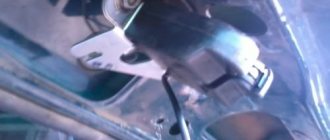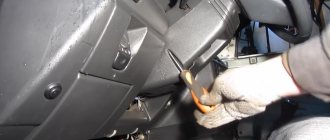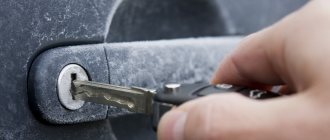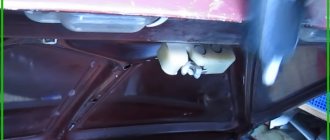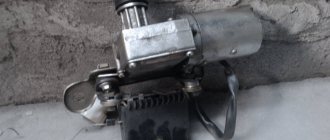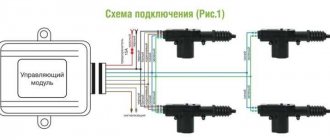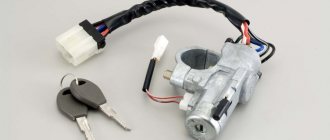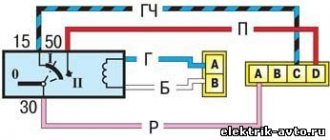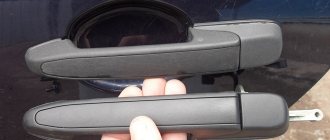How to open a padlock without a key?
A simple and logical method is to knock down the lock. With a large hammer or crowbar you can easily rip off the shackle to avoid the need for forced entry. It is enough to saw through the jumper with a metal blade. But this method will not work if the device is made of high-quality steel.
Attention! There are two ways to open a padlock associated with the grooves of the structure. There are several springs inside the device. The bow opens when the springs take a certain position. But this is not a complex program, but the most common mechanics. You can take a teaspoon and rest its handle against the lock, and then hit it hard with a hammer on the other side. The spoon will fit into the nest. After loosening the springs, open the door.
There is a system on disk and combination locks that causes the device to jam when you try to open it. But when making padlocks, the manufacturer does not pay much attention to this. If the locking mechanism is small, then the spoon and hammer can be replaced with a hunting knife.
The socket can be unscrewed. To do this you need a self-tapping screw, a screwdriver and a crowbar. Using a screwdriver, a self-tapping screw is screwed into the lock, leaving the bolt head on the surface. A crowbar is used as a lever. The mask is taken out of the nest, and the door opens.
To break the bow, use open-end wrenches. Position the keys so that the shackle is between the horns of the keys. The tools will touch each other. Move the opposite ends in different directions and when the keys rest, press down. The bow will break or fly out of its socket. Using the same principle, you can quickly break a padlock using a hammer and a pry bar.
How to open a mortise cylinder lock
There are 2 approaches to opening a cylinder device: rough removal, manipulation with master keys and improvised objects. The first group includes methods after use of which the lock must be replaced:
- The cylinder is knocked out using a chisel or crowbar. The tool is rested against the cylinder and hit hard with a hammer. Without additional protection, the lock easily falls off. After this, use a screwdriver to move the bolts and open the door.
- If the larva protrudes above the canvas, it is captured by pincers, rocked and removed.
- A hole is drilled in the cylinder slightly below the well. You will need a drill and a thin iron drill bit. After this, insert a thin flat screwdriver and press the plates towards the opening.
Picks from improvised objects and ordinary tools will help you open the lock without damaging it. You will need a flat thin screwdriver and a steel pin. The tip of a flat thin screwdriver is bent at a right angle. The curved screwdriver is inserted all the way and turned slightly. It will hold the pins. Insert the point of a pin and gently move the pins until they are in the desired position.
How to pick a lock without leaving it intact?
Opening a padlock without breaking the integrity is a task for an experienced locksmith. There are two methods that can be used for this purpose, but they require skill and patience.
For the first, you will need a strip of aluminum measuring 4x10 cm. The strip is drawn with three parallel lines into 5 parts. The middle line will divide the strip in half. Then the bottom half needs to be divided again into 5 parts with vertical stripes. From the end of the middle vertical strip you need to draw a line to the intersection of the adjacent vertical and horizontal strips. Then mirror this with the second vertical stripe. The result is a triangle. It needs to be cut with scissors. Then fold the remaining strip so that it is comfortable to hold with your fingers. How to do this, everyone decides for themselves.
The flat tip of the triangle is then pressed into the gap between the shackle and the socket where the shackle is inserted to close the lock. With force, the triangle is inserted into this hole, and the bow opens. Now you know how to open a padlock without a key.
You can use a paper clip and a women's bobby pin. The invisible piece needs to be cut into 2 parts with pliers. Then flatten the cut area. The master key is inserted into the lower part of the hole in the lock, then bent. You need to turn the hairpin several times, and then use a straightened paper clip.
The paperclip is inserted all the way into the deep part of the hole. After this, the pin must be loosened from side to side, pressing it to the bottom of the socket. If everything is done according to the instructions, the structure will open and the lock can be removed. This method is used to open a mechanical lock, but it is not always successful the first time.
Tips and tricks
Even if everything is done correctly, the socket will become loose and will not hold the bow tightly. It is better not to use the device after opening, and to use a master key for opening only if you have lost the key.
Important! The opening method depends on the quality of the shackle and the manufacturer. The Chinese mechanism can be knocked down on its own, but with German models you should be delicate.
Metal can be sawed through. It's only a matter of time. Therefore, if none of the methods work, you can cut down the old device with a hacksaw. But if it’s freezing, the device may simply be frozen. In this case, the structure needs to be warmed up and under no circumstances should you try to saw through it - this is not the best remedy in sub-zero weather. It’s easier to disassemble the handle or wait for a thaw, leaving the door closed.
It is not so difficult to pick a lock, but after doing so it often becomes unusable. This should be taken into account before starting the procedure.
Replacing the lock cylinder and checking its functionality
After purchasing a new door core, you need to install it immediately. It is advisable to lubricate the inside of the lock where the cylinder will be inserted. The installation process is the reverse of removal.
The peculiarity of this work is the correct installation of the cylinder in the door and the installation of the mounting bolt in the desired hole.
When replacing the lock cylinder, you need to be extremely careful
You also need to be extremely careful so that the larva does not fall inside the door; it is unlikely that you will be able to get it out.
To do this, you can move the cylinder a little so that the bolt takes its place. The key is in the “Closed” position.
After replacing the core, you must check the lock for functionality. To do this, gently turn the key in the lock of the slightly open door; it should turn freely and not slow down. The lock should not creak or click. Only after this can you close the door and turn the key again. The locking mechanism should close smoothly.
Preliminary preparation
Before drilling out the cylinder, you need to know exactly what category the lock belongs to, that is, its burglary resistance class and type. In addition, it will not be superfluous to know whether the mechanism is equipped with protective armored linings on the outside or inside of the door, in which part the secret pins are located and their number.
The burglary resistance class is specified in the product passport; locks of classes 3 and 4 are considered the most reliable; accordingly, breaking such a mechanism is much more difficult.
By type, locks are divided into cross-shaped cylinder, pin cylinder, overhead lever and armored. The most common is a cylinder lock, the cylinder of which can be drilled out and then replaced with a new similar one. But it is worth considering the quality of the material and the equipment of the cylinder lock. For example, the cheaper the mechanism, the easier it is to saw out. More expensive analogues are equipped during assembly with hard inclusions inside the well, on which drills break off. The hardened steel of the locking mechanism, its core and the pins inside are also not amenable to drilling, even with a high-quality drill for hard metals.
Of course, in a budget product you can drill out the cylinder yourself and replace it with a similar one with a new set of keys, which is very convenient for those who often forget or lose their keys. This will not work with a high-quality, expensive lock; you will have to call a specialist with master keys, wasting your time and money. But do not forget that such a device will more reliably protect personal space and property in the apartment.
Inspect the locking mechanism
Determine what?
- Presence/absence of armor plate.
- The degree of protection of the larva, including from unauthorized removal. Many models of cylinder locks provide for this, and therefore special inclusions made of hard alloys are placed in the borehole. When you try to open the door in this way, the drill quickly breaks.
Based on visual diagnostics, you can understand:
- how to drill out the lock cylinder correctly and what needs to be prepared;
- is it worth doing? This statement may seem strange to some, and therefore something needs to be clarified. To remove the core in some models of locks installed in doors, it is not necessary to drill it; the larva can simply be knocked out with a hammer and a fairly strong screwdriver (or a piece of metal rod). And this will take much less time, and the technology itself is so primitive that even a teenager can handle this work.
Prepare everything you need
- electric/drill. It is desirable that it has a speed control function, and that the tool runs on mains power rather than battery power. In the absence of one, a screwdriver will also help;
- extension cord (carrying);
- drill. There is a rule - its diameter should slightly exceed the width of the slot into which the key is inserted (for most cylinder lock cylinders it should be 3 mm); quite enough for accurate drilling. But this is the main working tool. For primary drilling, smaller analogues will be needed. For example, at 0.5 and 1.2.
- punch, hammer, screwdriver with a narrow blade;
- machine oil.
Tool for drilling the cylinder
Before work, it is better to prepare everything in advance so that during the process you do not have to interrupt and look for missing equipment. The main tool is an electric drill with a sufficient level of power and adjustable rotation speed. It is better to take a tool that operates from the mains, so that the battery does not unexpectedly run out during operation.
A thin metal drill is selected for the drill, slightly thicker than the bore hole, usually 3-5 mm is enough. For convenience, it is also recommended to take a center punch, with which you can mark the entry point of the drill; in this case, the drill will not jump off the relief surface of the core and will not damage the lock body or the surface of the door leaf. Instead of a punch, you can use a thin awl.
In some cases, 6 and 19 mm drills are selected for greater effect. The first drill is used for additional boring of the hole in order to accurately drill all the pins and pick up the lock. A thick drill corresponds to the diameter of the entire cylinder and is used if it is impossible to pick up the stopper through a small recess. But you need to understand that after such a hack it will not be possible to replace only the core, since the entire lock is damaged, so you will have to buy a new one.
To open a broken lock, you will also need a thin flat-head screwdriver, which will tighten the stopper, hook, or bent wire to latch the lock.
Definition of the "working" point
Everything is clear about how to drill out the larva - with an electric drill. But where exactly to install the drill is an important question. Regardless of the modification of the cylinder lock (pin, plate, disk), the “channel” must pass near the installation of the security elements. Then the larva will come out quite easily.
There is one more rule for this - the optimal drilling point is ¼ of the length of the slot above its lower edge. That is, the well is conventionally divided in half, twice; there will be no error.
Preparation of the work area
Before you start directly drilling the lock, you must prevent the possibility of the tip of the tool sliding on the metal. Therefore, the “entry point” is marked with a center punch, otherwise there is a high probability of damage to the cladding, insulation and door leaf material.
How to drill
A drill of the smallest thickness is installed at the entry point indicated by the center punch, after which the drill is turned on. The first millimeters are passed at minimum speed without excessive pressure on the drill, then you can add speed. A minimum of effort and speed will allow the drill to move slightly into the metal without breaking. During the entire drilling process, it is not recommended to rush and work at maximum speed, as this can lead to breakage of the drill, after which you will have to look for a new one, which takes a lot of time.
The drill is installed perpendicular to the borehole, gradually tilting at an angle, which makes it possible to quickly get to the pins and damage them. Experts recommend soaking the drill in mineral oil every couple of minutes to make work easier.
If you notice that the cylinder has become harder to drill, and the drill itself is biting or sticking, reduce the speed, reverse and remove the drill from the recess. It would be a good idea to blow out any metal shavings that would interfere with the interior view.
As soon as you feel that you have reached the last pin, change the drill to a thicker one. This will allow you to drill out the lock cylinder until the pins are completely destroyed. How to do this using the front door as an example is shown in the video below.
Lock-type drilling technology
It is recommended to install a lock with a cross-shaped cylinder in interior doors and doors leading to offices, retail or utility rooms, in other words, in those rooms that are additionally protected by more durable doors or alarms. To open such a lock, you will need to drill a hole just above the keyhole to the pins, and then tighten the lock with an awl or a thin screwdriver. Simultaneously with raising the stopper, the bolt is pulled back using a hook made of thin wire, which will cause the bolt to move inward and open the door.
The cylinder with pins is drilled in a similar way, and then rotated inside using a thin tool, such as a screwdriver.
The keyhole is drilled using a 3 mm drill. To prevent the drill from breaking, it is recommended to place it strictly perpendicular to the borehole hole. If drilling does not help, you will need to make another hole above the hole, and then use a hook to move the bolt.
An overhead lever lock is drilled where the post is attached to the edge of the bolt, usually just above the center of the bore hole. After drilling the rack, the lever lock is opened with a non-original key of a similar type or its blank for a future duplicate. But you should understand that drilling will only help if the product is not equipped with additional protective devices.
Locking mechanisms made of hardened steel or armored with linings are drilled using a heavy-duty carbide-tipped drill. Finding such a drill is problematic; in addition, it is quite expensive, and you will have to work hard to drill it. Therefore, it is easier to leave this matter to a specialist, whose call will cost approximately the same amount as a heavy-duty metal drill.
Pins are destroyed, what to do next?
Take your time with the final destruction of the larva after drilling the pins. In most cases, it is enough to place a flat-head screwdriver inside the drilled recess and twist to open the lock. If the lock does not open with a screwdriver the first time, most likely the pins are not completely sawn or the core is equipped with additional protection against hacking. In this case, try drilling the hole with a slightly thicker drill and repeat the action with a screwdriver or hook.
How to open a padlock without a key
Today, an old padlock is often found in a garage, pantry, attic or warehouse. The main advantage and reason for the prevalence of a padlock is its low cost, simplicity of design and, at the same time, reliability.
Related article: How to change the cylinder in a door lock
It is simply impossible to open a door with such a lock if the key is lost, because... the lock shackle is made of steel, and garage and warehouse doors are usually metal.
Also often the reason for the inability to open the door is wear and tear of the security mechanism. Over time, due to regular use, its internal secretion may simply wear off. If the lock hangs in the open air, due to the influence of external factors (moisture, frost), the formation of corrosion centers is simply inevitable. In this case, if there is no desire to use an angle grinder and damage the canvas, anyone will think about how to open a padlock.
This is actually a fairly common problem. Many different methods have been accumulated to solve it. Many people resort to a master key made from an aluminum can. You can easily make a shamrock shape using an empty Coca-Cola can. The mechanism itself is broken using the middle tongue.
Opening with a paperclip is the most effective and long-proven method of working with a jammed padlock. The specificity is to get a bent paper clip or wire into a special clamp, which should unclench and release the staple from the base. In some samples, a button is provided instead of a latch; the operating principle is not much different. A wire bent in the shape of an G must be inserted into the hole and slowly and carefully turned.
It is important to remember that during rotation you should pay attention to which direction the mechanism turns easiest.
Next, a second master key of the same type is used and inserted into the upper area of the keyhole in order to find special pins, which, after detection, gradually rise. After all the pins are open, the lower pick is turned again.
In most cases, you can open a padlock yourself using a regular pin, knife, or special master keys, which can be found in craftsmen or locksmiths. You can learn more about how to open a semicircular padlock without a key in the corresponding video. Often, with the help of o, it is important to assemble the required lock combination, which is presented in the form of a set of ordinary horizontal plates.
It should be noted that some models of padlocks with a semicircular key are quite resistant to burglary, so their owners often turn to specialized services.
Opening a padlock yourself
Today there are many ways to open a padlock. Many of them are used by professional craftsmen, and some are suitable for absolutely any person, which will be discussed. To open it ourselves, we first have to understand the structure of the lock and understand the principle of operation of the mechanism.
One of the most well-known methods is to open the lock using a paper clip, hairpin or elastic wire. There is a latch in the lock mechanism, which we will try to unlock using these tools. To do this, we insert a correctly straightened paperclip into the keyhole and pick it out, hooking the latch.
Often, padlocks use a mechanism whose operating principle involves pressing a special button. When the key gets into the keyhole of such a lock, the same button is pressed - this leads to the opening of the mechanism. Therefore, there is nothing complicated in the process of opening this lock and, thanks to the tools at hand, you can try to press the button.
Often, padlocks use a mechanism whose operating principle is to press a special button
The most commonly used locks are those whose mechanism is powered by a spring. Sometimes such locks are used in suitcases and travel bags. These are often Chinese locks and can be opened using a simple knife. This method does not always work, but you can try it, as it does not require any effort. You can experiment using the same paper clip or nail. The main thing is to try to get to the spring and press on it.
There is a method for opening a padlock using a tin can. It is enough to simply cut out a trefoil of the correct shape, which we then insert into the hole of the bow and try to free it from the latch.
To open the lock yourself, in any case, you need to work hard and spend your time. It is often much easier to contact a special service, whose specialists will perform a prompt and high-quality autopsy. In this case, your lock will remain in working order and will last for many years to come!
How to open a combination padlock
In this case, there are several ways. The first and most common requires the selection of a combination. First, you need to pull the locking shackle until it begins to put pressure on the wheels. After this, you should make rotational movements until a click occurs and the lock opens.
The second method is more complicated. To open it, you will need an aluminum plate, which can be cut from a tin can. This semblance of a key is rounded to a diameter corresponding to the width of the arch. The plate is inserted into the hole located between the body and the bow. At the very end, after the procedures have been completed, it is necessary to apply some force for final unlocking.
How to open a disc padlock
A characteristic feature of this mechanism is the presence not of pins, as in other models, but of several disks with specific holes, which significantly complicate entry into the room. To ensure that the discs are placed in the correct position, it is important to select a wrench with suitable grooves.
Padlock disc
Considering the specificity of the design, with minimal loss of time, you can open a disc padlock without a key only with a correctly selected master key or a bent flat-head screwdriver, which must be driven into the lock and turned with force.
How to open a barn lock without a key
It is important to remember that barn locks are those samples that have a standard round shackle. Therefore, old-style garage locks often fall into this category.
A medium-sized and small-sized lock installed on a wooden door can also be opened by force. A regular crowbar is suitable for this purpose. It is necessary to insert the tool through the bow and, using the lever method, tear it off.
It will be more difficult to open the rack lock using the method described above, so here it is worth using fishing line or a string from a guitar. First, you need to press the door with a crowbar, then a loop is made from a string, which must be inserted into the hole, circled around the pins and pulled towards you. For clarity, below is a video.
How to open an Apecs lock without a key
For those who have wondered how to open a padlock from such a manufacturer, any specialist will answer that the methods are practically no different from those given above.
It should also be noted that Apex's products are designed for mass use and their price does not exceed the average. Therefore, hacking this mechanism will not take much time and effort.
How to open a Chinese padlock without a key
Samples made of Chinese steel are, as a rule, unstable to force. The steel of overhead locks is quite soft, so if you have an angle grinder, the opening process will not take much effort and time.
When using a crowbar, you will need to apply force, but it is still important to choose the right angle.
Opening different types of locks
Humanity has come up with a huge number of castle designs. Some turned out to be too complex to implement and unreliable, some, on the contrary, were too primitive, and both are used extremely rarely or not used at all. Next, we will consider the most common types of locks and methods for breaking them.
Rack locks
This type of locks is quite simple in structure. There are bolts protruding from the case, there are mounting holes and a through key hole. Inside the housing, built into the door, there are crossbar slats, which are columns that cover the lock. These slats are pushed outward by a spring.
They contain grooves located at an angle to the vector of movement of the bolt.
Since the structure includes several crossbars, there are 2 ways to break it:
- Between the doors there is a gap through which the bolts should be moved one by one. The crossbars are allowed to be moved with an awl through the key hole.
- Make a metal loop from string. A tube is inserted into the keyhole, a loop is inserted into it and placed over the handles of the bolts, moving them.
Rack and bolt locks can be easily opened with a universal master key made from the same key.
Cylinder lock with cross plates
The locks are equipped with special keys, which have a cylindrical working part, cut vertically, and on the transverse side, it looks like a circle cut in half. The design of the locks has low reliability indicators; they can be easily opened with a high-strength steel master key.
It can be hacked in several ways:
- The lock opens by turning a rod made of high-strength material.
- If you have a drill with drill bits, you can actually drill out the cylinder in a couple of minutes.
Scheme for opening a cylinder lock.
Experts say that if you have a choice, it is better to choose another lock, since experienced burglars can break into a cylinder lock with cross plates in a few seconds.
Cylinder lock with pins
In addition to the bolt drive and cylinder, the composition includes a metal or steel body, pins with return springs, and a cam that moves the bolt. Pins in contact with the key or with blocking the lock mechanism relative to the body.
Keys are cylindrical tubes with teeth, holes or cutouts in the same number as there are pins in the lock body.
Many offices and schools built in Soviet times still have such locks, which are not distinguished by high levels of protection and reliability. For greater reliability, multi-row keys with perforation at the end are used.
Lock device.
To break into a structure, you will need a special device that resembles a turnkey blank, called a roll:
- A blank key is inserted into the keyhole and turned there using a lever.
- The roll has greater durability than pins. The pins will begin to wear, causing the lock to open.
The lock is inexpensive and is installed on doors behind which particularly important and valuable things are not stored.
Level locks
The design contains a secret part in the form of figured plates. It will only be possible to open it when all the plates are in a certain position. This is a very common type of locks installed on metal doors of garages, offices or industrial buildings.
The suswald lock has 3 round bolts. It has good reliability indicators if it is made from high-quality and high-strength materials.
The same package known to us can help open the lock. It is inserted almost all the way and turned until it stops. At the same time, use a knitting needle and hook to move the first plate. At the same time, you should try to turn the roll at least a quarter of a turn.
The plate gave way when it was possible to do this. The same actions should be carried out with other plates.
Barrier
This type of lock is distinguished by the design of the security mechanism. In other locks, the pins are arranged in one row, but in a barrier they are arranged in a circle. Due to this, secrecy increases, and it is much more difficult to open it.
The key is a tube with holes of different depths marked on it, representing a coding. It is almost impossible to take an impression of such a key.
The barrier lock structure is opened using:
- Spin. The fastening of the inner part of the lock is broken and the steel rods are torn.
- Master key. Used when the code pins are worn out.
- Selection of keys. It is very rare, but there are cases when the lock can actually be opened with a key similar to the original one.
However, picking these types of locks is a big challenge because they were designed to be as secure as possible.
Ways to break different types of padlocks
Padlocks were the first to be invented and have been used for thousands of years. Nowadays, they are no longer serious opponents against hackers, but for the average user they can become a real problem. How to break a padlock? The answer seems obvious, take it and cut it. However, not everything is so simple; often the mechanism arms are massive, made of hardened steel. It won't be possible to saw such a part, and it won't be possible to chop either, what should you do in this case?
Related article: Lost the keys to the apartment, how to open the door
Existing types of padlocks
You can only cut with a grinder, but this is not always convenient. So, how to break a padlock when the need arises?
What is an entrance door lock cylinder?
The lock cylinder serves to transmit force from the key to the door mechanism.
The most popular are English locks, that is, those with a cylinder type of secret mechanism (cylinder). This element serves to transmit force from the key to the door mechanism. The cylinder can only activate the bolt when the corresponding key is inserted into the hole, which the secret system recognizes as “its own” and begins to rotate.
The cylinder mechanism has an elongated shape, so in simple terms it is also called a larva, secret, etc. The popularity of such locks is explained by the fact that they are easy to maintain; opening them does not require much effort and the key is small in size. If the cylinder fails, it can be quickly replaced, without requiring disassembly of the entire lock or its complete replacement.
Why is replacement needed?
The cylinder mechanism fails gradually, so during operation you should pay attention to extraneous sounds when turning the key.
There are a number of obvious reasons why it is necessary to replace the cylindrical mechanism:
- mechanical failure of the larva body;
- lost key;
- breakage of the key inside the cylinder;
- apartment purchase.
A cylindrical secret rarely fails suddenly, so if it is not replaced in time, there may come a time when the mechanism is blocked and you will not be able to get into your house or apartment.
It is important to pay attention to the following signs:
- the key jams while turning it, but when you wiggle it a little, it opens the doors;
- When inserting and turning the key, extraneous creaks or crunches appear.
When the pins wear out in the cylindrical mechanism, when the key is inserted, they do not rise to the required height, so the secret does not unlock.
Break or open
If a situation arises in which it is necessary to remove the padlock (it is not a matter of unauthorized opening), you should not immediately run for an angle grinder or other equipment that allows you to cut and rip off the mechanism, you may be able to open it so that later, after restoring the set of keys, you can use it for its intended purpose . The simplest in terms of opening, the so-called disc lock systems, they have a simple structure, various sizes, a durable shackle, but they are very easy to unlock.
Internal structure of a disc padlock
Disc locks have a semicircular key, and the operating principle is based on manual unlocking and locking.
- The disc lock can be opened with a suitable screwdriver, which is inserted into the hole, gradually turning each of the secrets. Everything is very simple, after 5 minutes of training, the mechanism will be unlocked.
- Alternatively, you can make a key-like semicircular master key by grinding off a bolt, nail or old broken screwdriver. The unlocking principle is the same as in the first option.
Also, such a padlock can be removed using a key from another similar mechanism. Often they are practically the same. It’s even easier to break not the lock, but the hinges into which it is inserted, but this option is possible if they are made of very poor metal, or are simply screwed into the door frame. A more serious obstacle will be a padlock with a flat, so-called English key, or a massive barn equivalent. It cannot be opened without experience, which means the easiest way is to cut it, break it, or knock it down.
How to knock down a lock
If the location of the lock allows, then you can try to knock it down using a hammer, sledgehammer, or even an ax. To do this, select a tool, and by striking the center under the shackle, the mechanism can simply be torn off the locking mechanism. The second option, similar to the algorithm, is to take a chisel and, placing it in the middle of the lock, knock down the mechanism with strong blows. In this case, you need to work carefully without hitting your hands or fingers! If you have a powerful bolt cutter, you can simply bite through the shackle. This is especially easy to do with cheap Chinese mechanisms.
There are two types of locks installed on garage doors.
- A lever lock is much better suited for garages located in cities where winters are colder. They are equipped with plates inside and springs, the borehole opening is narrow, the lock is already lubricated deep inside during production and therefore the penetration of dirt, dust, water, and moisture usually does not occur.
- It is better not to use a cylinder lock at all for a garage door where it is frosty. If even a drop of moisture or dirt gets into it, it will freeze and may not even open at the most inopportune moment. The mechanism is not for the street, the elements inside are thin and small, located at wide distances and quickly fail.
If you still have a cylindrical lock and it is jammed, you do not need to lubricate it, the lubricant will not help, but will only thicken in the cold and such a lock will no longer be able to be opened at all, but only cut off with a grinder.
So, the problem is the lock, which is not suitable for use in sub-zero temperatures. There were changes inside the mechanism, and most importantly, moisture appeared in the lock. Now it’s easier to think about how to get rid of moisture and freezing.
How to break different types of padlocks
It is very easy to break various types of padlocks if you have the necessary tools and also know which opening principle to use. Ways to break different types of padlocks:
- Massive hangar locks are easiest to knock down or break using a crowbar or pry bar. The thing is that the mechanism itself cannot withstand the load when you press it from above. You need to proceed as follows. A lever (crowbar, crowbar, nail puller) is inserted into the bow, the end of which rests against the door or wall. Having received emphasis, they press down on the instrument from top to bottom. If you press hard enough, the barn lock shackle will pop out of the locking mechanism.
- Locks with insert cylinder. Usually these are square products with a U-shaped cutout at the top, into which loops are inserted, through which a locking cylinder is passed. Such a lock is also easy to break; a lever is inserted into the opening, with the emphasis on the wall or door. The force must be created in the direction opposite to the inserted cylinder, which, when pressed firmly, will pop out of the lock.
- Chinese locks with English keys can be broken using two wrenches or an adjustable gas wrench. The main problem with such mechanisms is that they are made of very low quality steel or pressed metal powder. You need to proceed as follows.
This is what a Chinese lock with an English key looks like
Two wrenches are inserted into the shackle, one opposite the other, resting their ends. Next you need to close their ends with millet. As a result, the shackle will break, or the lock itself will break if it is of poor quality. They work the same way with an adjustable wrench; they insert it into the center of the mechanism and separate the ends, breaking the metal. Such cheap systems can be dealt with even using pliers.
- Locks with a rotary washer. These systems are usually unlocked with square keys. Such mechanisms also have their weak point - a rotating washer that protects secrets. To break them open correctly, armed with a screwdriver, insert it into the hole not all the way, resting against the edges of the washer. By pressing the lever, you can tear out the protection, after which all the secrets will simply fall out, and all you have to do is turn the screwdriver inside, opening the system.
- Designs with a cross cylinder. They are made in the form of an overhead circle or square, locked with just one pin. To break it, you should take a suitable device that allows you to rip out the locking cylinder from the pin.
Example of a cross cylinder lockWith the help of master keys, you can unlock even the most reliable hinged devices, no matter what kind of lock is on your door. But this kind of thing requires a lot of experience. The unlocking principle is as follows. Two devices are made from two paper clips or steel wire. The ends are bent to obtain an L-shape.
Set of master keys for opening a padlock
One of the improvised master keys is inserted into the well, turning it in a circle and feeling for the mechanism. When it rests against it, a second one is inserted, which is used to squeeze out the secrets; when they are all unscrewed, the first paperclip is turned, then freeing the lock shackle from the stopper.
You can also try to open a padlock without breaking it by cutting a device from a tin can in the form of a strip of metal, ending with a “T” shaped bridge.
The video shows the most popular methods of opening locks.
The narrow end is wrapped around the bow and inserted into its fixation hole from above, turning the strip inside out. By wrapping it around the axis, you can try to press the stoppers, further releasing the mechanism's bow. It is very easy to open or break padlocks with your own hands. The main thing is to accurately determine the type of system and apply the necessary breakdown technique.
Which padlock is the most reliable?
After reading as much as possible in this article, any owner of a barn and garage will think about how to ensure the safety of the garage and other premises. To do this, you just need to buy a more reliable lock than the one you opened and put the keys to it in safe places so that you can access them if you cannot find yours.
Choose a large lock made of durable steel and a thick, strong shackle for your garage. The thicker the shackle, the less effective the crowbar. Choose a lock with the most modern mechanism design. And try not to find yourself in such a situation again. To prevent the lock from jamming, it is better to provide timely care for it - lubrication. Lubricants are produced in a wide range by manufacturers of locking systems. As soon as you feel that the lock is jammed, change it.
If you need to open a lock urgently and you don’t have time to gain interesting, but not always necessary experience in opening a lock with a paper clip, it is better to call a lock opening service that has all the necessary tools, as well as amazing experience in opening systems of any design. Moreover, an experienced master will be able to open the lock in such a way that it remains fully operational and suitable for further use.
Revenge is a strong feeling that sometimes overwhelms you. But it should be served cold, and in measured doses. Do you live in a multi-storey building and are you bothered by extra noise from cheerful groups above, or are you tired of your neighbor doing constant repairs? Does a hammer drill buzzing behind the wall lead to neurosis? So, we are on the warpath. The first thing that comes to mind is to damage or ruin the lock on your neighbor’s door, and do it unnoticed, without vandalism.
Reasons leading to the desire to damage the door lock:
- envy, neighbors' gossip
- loud music at night
- baby's incessant crying
- howl, barking dog
The most common conflicts are caused by a neighbor’s desire to smoke on the landing, when tobacco smoke directly seeps into your apartment. Prayers and requests don't help? Is the belief not relevant? Then you need to damage the lock on the door so that the neighbor cannot go out and smoke!
Your ceiling is your neighbor's floor, but he doesn't understand it? Before you damage the lock on the door, you need to remember about Article 167 of the Criminal Code of the Russian Federation “Deliberate destruction or damage to property,” which provides for criminal or administrative punishment.
Legal methods don't help? Let's get to the bully stuff! So, you got a neighbor - minimum communication, maximum pleasure! But, most importantly, remain calm and equanimous.
Ways to ruin the lock on your neighbor’s door or break or damage the locking mechanism:
- Pour instant glue into the keyhole
- Push toothpicks and pins
- Use cold welding
- Foam with polyurethane foam
- Screw a self-tapping screw into the lock cylinder
- Stick the gum in
- Drive a ruble coin into the lever lock
- Drive a similar key into the core of the lock and break it there. The situation can be attributed to an attempted robbery using a key.
These are the most common ways to ruin a door lock, but there is another invisible one that is familiar only to professional experts who open door locks.
How to spoil or damage the lock on a door without being noticed?
In order to damage the lock unnoticed, you should go to the door and press the door handle. You should press smoothly, but with force, until a crunch appears. The latch—the tongue of the lock—breaks and gets stuck between the door leaf and the frame, resulting in the door being blocked.
Only a professional who is familiar with the lock's structure can open a locked door. The neighbor will not be able to open the door on his own without damaging or using an angle grinder! After opening, you will inevitably need to replace the lock with handles on the front door.
Conclusion: any door locks that have a reed mechanism and are equipped with handles can be imperceptibly damaged!
The most common door locks that can be damaged unnoticed are:
One of the most popular types of locks is the cylinder or, as it is also called, English. Now this locking mechanism is being replaced by other, more reliable and safe systems, but the cylinder lock is not going to lose ground. Moreover, it itself also quite confidently and effectively protects the premises from intruders, naturally, if you purchased a high-class product. In addition, it is easy to install on the door leaf, and a small key can easily be placed in a trouser, jacket, or jacket pocket without causing any inconvenience to the owner.
However, unfortunately, it is not uncommon for it to break. There may be several reasons for this:
- long-term operation without preventive lubrication;
- careless handling of the device;
- moral and physical wear and tear of internal parts, etc.
Keys are even more often lost. What should you do if the lock is broken or you have unintentionally classified yourself as a loser by losing your keys and unable to open the door? In this article we will look at how to knock out a lock
.
What to do if you put a lock on the car door handle.
To prevent this type of extortion from developing, you should follow a few simple rules. First of all, advice for those who are faced with a lock on the door handle of their own car:
The simplest thing is to call a specialist to open the lock. It will cost 1000 rubles, everything will be done in front of you. But this information is not for the purpose of advertising services, the main thing is that the scammers will not get the money, and the incentive to repeat will disappear. Options to remove the lock yourself.
Cut the lock shackle with a hacksaw
The padlock can be cut off with a hacksaw. Extortionists (they are often called scammers, but this is incorrect) hang relatively cheap locks that usually cannot resist a regular hacksaw.
Wrap the handle and lock with any suitable rag so as not to damage the paintwork of the door, be patient and saw through the lock shackle. Choose the cutting location based on the ease of holding the lock. Saw where it is convenient. An average-sized castle will take about 20 minutes.
If you don’t have a hacksaw, just a blade for metal unfortunately won’t work, you won’t have the patience, and after an hour of work you’ll be looking for another option.
Cut with a grinder
The lock can be cut using an angle grinder (grinder, fortune) and a cutting disc. To do this, you need a 220V socket, the grinder itself and the ability to protect the machine from sparks, because... they can leave a mark not only on paint or pen, but also on glass.
Before sawing, take 10 minutes to cover the machine thoroughly. Do not use dirty rags, which can easily ignite. Follow safety regulations.
A quick option to protect the paint and glass of doors from sparks is to stick wet newspaper directly onto the clean doors and glass. The best option is a small sander with a 125 mm disc.
Cut through the lock shackle with a bolt cutter
A bolt cutter can help out in this situation.
It’s also a specific tool, but it can handle a lock in record time. You bite the shackle and the lock releases the handle.
Disassemble the door from the inside to remove the handle
Another option is to remove the handle from the door to release the lock. Requires door panel removal. You need the usual tools that can be found in the car, but you need to know how to properly disassemble the door. This option is suitable if you have previously dismantled the door and have a tool.
Driving a car while the lock is still on the door handle
It’s unlikely that you have a sander or bolt cutter in your car. Most likely you will have to get there. It is also better to disassemble the door in a workshop or garage. To prevent the lock from damaging the handle and door, first wrap the handle with electrical tape. Then we wrap any rag around the lock so that it does not dangle in the handle. In the summer, you can try to hold the lock with your hand.
Drill out the “cylinder”, break the lock with a hammer, pick it out with a screwdriver, pick up a key - options that usually will not lead to success, the lock is designed to resist hacking using simple tools.
How to protect your car:
General advice that helps in other cases: Leave the car under surveillance cameras, in guarded parking lots, in a garage. It’s corny, but there are no better options yet.
The theft of license plates from cars has been a criminal offense since 2014, punishable by up to 4 years in prison. I am sure that something similar will be adopted regarding extortion with locks on handles; such dealers are caught quite simply, because The chain of money transfers is becoming easier and easier to track using technical means.
